Marvelous Minnesota mansions: Unlock the doors to 10 extraordinary historic homes you can tour!
Step into Minnesota's past as you explore its remarkable historic homes, providing a fascinating glimpse into the lives of influential figures, the architectural magnificence of bygone eras, and the cultural heritage of the region.
June 15, 2023
One of the best ways to delve into the past is by touring the top historic homes scattered across Minnesota
These magnificent dwellings open their doors to visitors, offering a unique opportunity to walk in the footsteps of notable individuals, explore architectural marvels, and immerse yourself in the stories that shaped Minnesota. Join us as we embark on a virtual tour of the top five historic homes that you can visit and experience firsthand.
Whether you're an avid history buff, an architecture aficionado, or simply seeking a captivating adventure, these homes promise an unforgettable exploration of Minnesota's vibrant heritage. So, prepare to wander through lavish rooms adorned with period furnishings, traverse beautiful gardens, and uncover the secrets that lie within the walls of these extraordinary homes.
Let's unlock the doors and embark on a remarkable journey through time as we tour some of the historic homes of Minnesota.
Turnblad Mansion - The Swedish Institute
2600 Park Avenue, Minneapolis, MN
Museum Hours: Wednesday to Sunday (10 am to 4 pm, 8 pm on Thursday), Closed Monday-Tuesday. Check their website for up-to-date admission fees.
Website: American Swedish Institute
The Turnblad Mansion, also known as the American Swedish Institute, is a historic mansion located in Minneapolis, Minnesota. Built-in 1908 for Swan Turnblad, a Swedish immigrant and successful newspaper publisher, this magnificent mansion is a prime example of the Beaux-Arts architectural style.
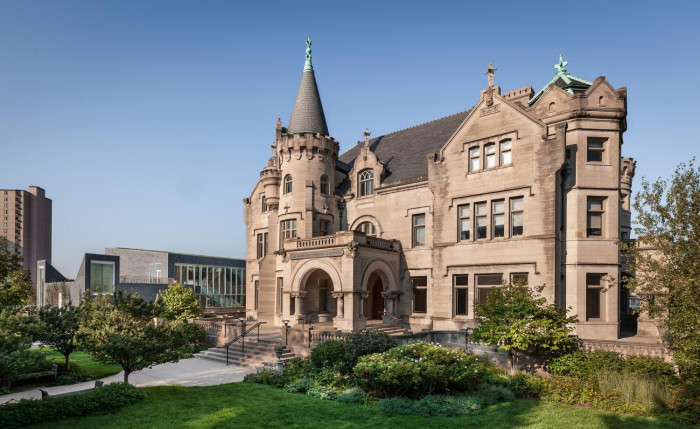
The mansion is a true architectural gem, featuring elaborate ornamentation, intricate detailing, and a stunning exterior facade. Its grandeur and opulence are immediately apparent upon arrival, with its majestic entrance, beautiful gardens, and an imposing turret that commands attention.
The Turnblad Mansion now serves as the home of the American Swedish Institute (ASI), an organization dedicated to preserving and promoting Swedish culture, art, and heritage. The mansion and the surrounding buildings have been transformed into a museum, cultural center, and event space, offering visitors a wealth of experiences and opportunities to explore.
Inside the mansion, visitors are treated to a delightful blend of European elegance and Swedish influences. The rooms are exquisitely decorated with period furnishings, intricate woodwork, and stunning works of art. The mansion's interior spaces include a grand ballroom, a lavish dining room, a charming library, and other beautifully appointed rooms that transport visitors back in time.
The American Swedish Institute offers guided tours of the Turnblad Mansion, allowing visitors to learn about the history of the mansion, the Turnblad family, and the Swedish immigrant experience in Minnesota. The tours provide insights into the cultural traditions, customs, and contributions of the Swedish community in the region.
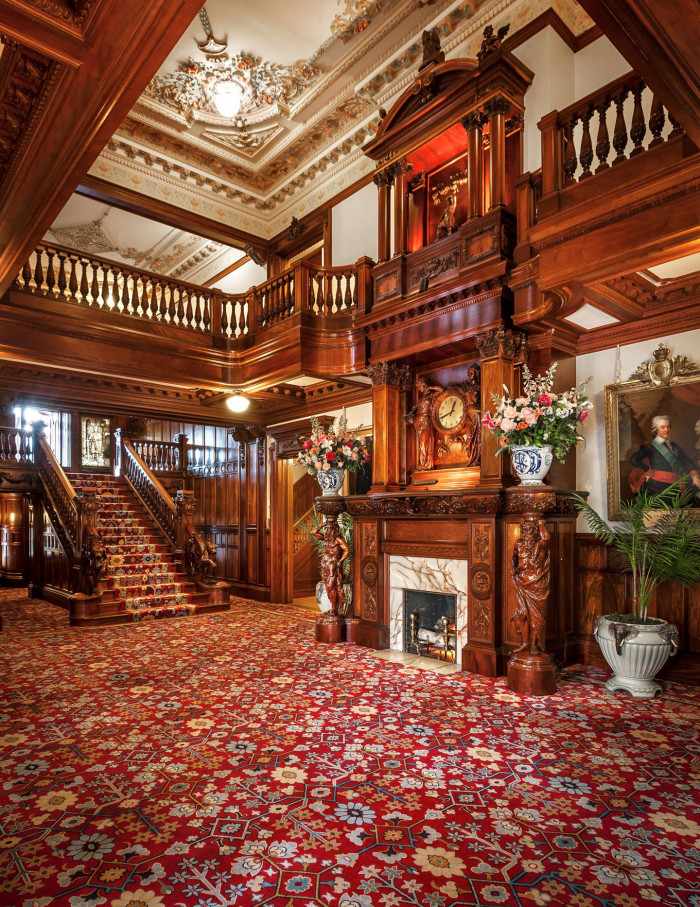
In addition to the mansion, the American Swedish Institute encompasses additional buildings that further enrich the visitor experience. The Nelson Cultural Center, a modern addition, features contemporary art exhibitions, a café, and a museum store. The Turnblad Mansion and Nelson Cultural Center are connected by a beautiful glass-enclosed courtyard known as the "Julia Morgan-designed" family room, which serves as a gathering space and event venue.
Throughout the year, the American Swedish Institute hosts a variety of events, exhibits, festivals, and educational programs that celebrate Swedish culture, arts, and traditions. Visitors can participate in workshops, culinary experiences, performances, and cultural celebrations that provide a deeper understanding of Swedish heritage and its influence on American society.
The Turnblad Mansion and the American Swedish Institute are not only architectural treasures but also vibrant cultural hubs that invite visitors to explore the rich tapestry of Swedish history, art, and traditions. Whether you are drawn to the mansion's stunning architecture, wish to learn more about Swedish culture, or simply seek a unique and enriching experience, the Turnblad Mansion and the American Swedish Institute in Minneapolis offer an unforgettable journey into the heart of Swedish heritage.
LeDuc Historic Estate
1629 Vermillion Street. Hastings, MN
Museum Hours: Thursday through Sunday, from 10:00 a.m. to 5:00 p.m. from mid-May to mid-October. Guided tours start at 10:00, 11:30, 1:00, 2:30, & 4:00. Check out their website for a complete list of events including Victorian teas, Hastings Historic After Hours, and reenactments. Check their website for up-to-date admission fees.
Website: The LeDuc Historic Estate
The LeDuc Historic Estate, nestled in the charming city of Hastings, Minnesota, is a remarkable historic gem that offers a captivating glimpse into the life and times of William G. LeDuc. Built-in 1865, this Gothic Revival mansion stands as a testament to the influential figure's legacy as a Civil War veteran, horticulturist, politician, and Minnesota pioneer.

The LeDuc Historic Estate is an architectural masterpiece, showcasing intricate detailing, steep gables, and pointed arches characteristic of the Gothic Revival style. The mansion's striking exterior is complemented by its lush surroundings, including beautifully landscaped gardens and expansive lawns that invite visitors to explore the estate's enchanting grounds.
Guided tours of the LeDuc Historic Estate take visitors on a journey through time, providing insights into the life and achievements of William G. LeDuc and the stories of the early settlers in Minnesota. As you step inside the mansion, you'll be greeted by elegantly furnished rooms adorned with period-appropriate decor and original artifacts that reflect the refined taste and lifestyle of the LeDuc family.
The mansion's interior features intricately carved woodwork, ornate wallpaper, and stained glass windows, all of which contribute to its rich historical ambiance. Visitors can explore various rooms, including the grand parlor, library, dining room, and bedrooms, each offering a glimpse into the daily lives of the LeDuc family and the social customs of the era.
The LeDuc Historic Estate extends beyond the mansion itself. The estate's outbuildings, such as the caretaker's cottage, carriage house, and icehouse, further enhance the immersive experience by providing insights into the estate's operations and the challenges faced by early settlers in Minnesota. The gardens surrounding the mansion feature beautiful flora and fauna, reflecting LeDuc's passion for horticulture and showcasing the estate's natural beauty.
In addition to guided tours, the LeDuc Historic Estate hosts special events, workshops, and educational programs that highlight various aspects of Minnesota's history, culture, and heritage. From gardening workshops to historical reenactments, these engaging activities provide visitors with hands-on experiences and a deeper appreciation for the past.
The LeDuc Historic Estate stands as a testament to the perseverance, vision, and contributions of William G. LeDuc and the early pioneers who shaped Minnesota's history. With its striking architecture, beautifully preserved interiors, and picturesque surroundings, the estate offers a unique opportunity to step back in time and explore the fascinating stories of Minnesota's past.
Hubbard House
606 S Broad Street, Mankato, MN
Museum Hours: Open Memorial Day Weekend-Labor Day Weekend, Friday to Saturday 10 am to 4 pm, Sunday 1 pm to 4 pm. Check their website for up-to-date admission fees.
Website: Hubbard House
The Hubbard House, located in Mankato, Minnesota, is a historic treasure that offers a captivating window into the life and times of its original owner, R.D. Hubbard. Built in 1871, this elegant Italianate mansion stands as a testament to the wealth, sophistication, and architectural grandeur of the era.
The Hubbard House is a magnificent example of Italianate architecture, characterized by its ornate details, tall windows, and distinctive cupola. Its exterior boasts a combination of brick and stone, with intricate detailing that showcases the craftsmanship and attention to detail of the time. The mansion's impressive facade stands as a proud symbol of its rich history.
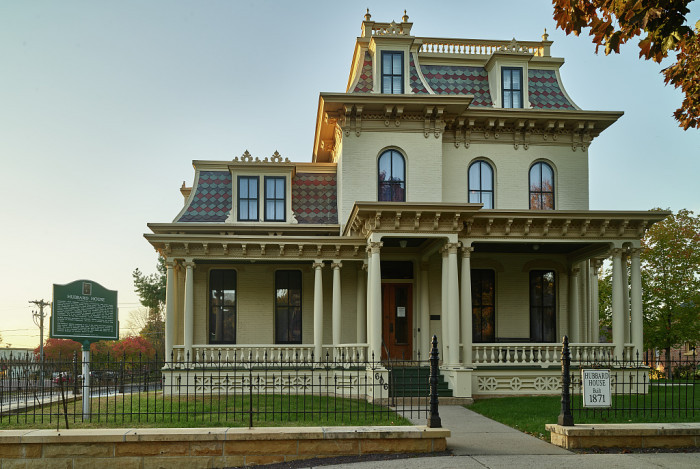
Guided tours of the Hubbard House provide visitors with a fascinating glimpse into the opulent lifestyle of R.D. Hubbard and his family. As you step inside, you'll be transported back in time, greeted by beautifully preserved interiors that reflect the mansion's original splendor. The rooms are adorned with period furnishings, intricate woodwork, and exquisite decor, allowing visitors to envision the luxurious lifestyle of the Hubbard family.
The mansion features various rooms, including a grand parlor, formal dining room, library, and bedrooms, each meticulously restored to capture the essence of late 19th-century elegance. Visitors can admire the detailed craftsmanship of the woodwork, marvel at the elaborate fireplaces, and appreciate the original artwork and decorative touches that adorn the walls.
Beyond the main residence, the Hubbard House also includes a carriage house and a beautiful garden. The carriage house, with its charming architecture, provides insights into the transportation methods of the era, while the garden offers a serene oasis with its lush greenery and vibrant blooms.
In addition to guided tours, the Hubbard House hosts special events, exhibits, and educational programs that delve deeper into the history and cultural significance of the mansion and the Mankato area. From historical lectures to themed exhibitions, these offerings provide visitors with a deeper understanding of the Hubbard House's place within the broader historical context.
The Hubbard House stands as a testament to the vision and aspirations of R.D. Hubbard, as well as the rich history of Mankato. It serves as a reminder of the grandeur and elegance of the past, preserving the stories and legacy of its original occupants. A visit to the Hubbard House is a journey through time, offering a glimpse into the lavish lifestyle and architectural beauty of the late 19th century.
The Fillebrown House
4735 Lake Avenue, White Bear Lake, MN
Website: The Fillebrown House
The Fillebrown House, also known as the C. P. Noyes Cottage, was constructed in 1879 as a summer retreat for the Charles and Emily Noyes family on the shores of White Bear Lake. However, after just two summers, the Noyes family relocated to Manitou Island, selling the property to George and Ellen Young.
George Young, a Harvard graduate and former attorney for James J. Hill, briefly served on the Minnesota Supreme Court in 1874. The Youngs cherished the cottage until Ellen's passing in 1905. Later that same year, J. Walter and Harriet Fillebrown purchased the property.

The Fillebrowns, successful wholesalers of fruit in St. Paul, desired a serene setting for their summer activities. In 1920, they made the decision to sell their St. Paul residence and convert the White Bear cottage into their year-round home. As part of this transformation, the separate summer kitchen was relocated to the rear of the house. Wood stoves were also installed in the bedrooms, enabling the house to be comfortably occupied throughout the year.
Recognized for its architectural design, the Fillebrown House was listed on the National Register of Historic Places in 1976. The interior of the cottage, described in the National Register nomination form, showcases the meticulous preservation of the stick-style decor. The intricate motifs seen on the exterior are echoed throughout the interior, with careful attention to detail evident in the construction of newels, balusters, window and door casements, door panels, and ceiling trusswork.
After the passing of the elder Fillebrowns in the 1930s, their children, Helen and Arthur, continued to reside in the house. Helen, an accomplished pianist, taught piano lessons to local children and operated a tearoom on the premises. At one point, the house even served as a nursery school. Much of the house's original character was retained from the 1920s to the 1940s.
In the 1970s, as Helen and Arthur aged, they generously donated the property to the White Bear Lake Area Historical Society to ensure its preservation. Over the past five decades, the society has been dedicated to the careful conservation and interpretation of this unique property.
The Fillebrown House stands as a tangible link to the once-vibrant summer community on the shores of White Bear Lake, offering a valuable opportunity to learn from our past. The White Bear Lake Area Historical Society remains committed to preserving this cherished historic site, ensuring its significance endures for future generations.
The Alexander Faribault House
12 First Avenue NE. Faribault, MN
Museum Hours: Please contact RCHS at 507-332-2121 to schedule a tour. Admission is $2.00 per person. RCHS members and children under 5 are free.
Wesbite: Alexander Faribault House
The Alexander Faribault House, located in Faribault, Minnesota, is a remarkable historic home that provides a fascinating glimpse into the life and legacy of Alexander Faribault, a prominent figure in the history of Minnesota. Built-in 1853, this Greek Revival-style residence stands as a testament to the early settlement and development of the area.
The Alexander Faribault House showcases the elegant architectural features typical of Greek Revival design. Its symmetrical facade, tall columns, and pedimented gable are prominent characteristics that exemplify the style. The exterior of the house has been meticulously restored to its original splendor, offering visitors a visual delight and a sense of the grandeur associated with the era.
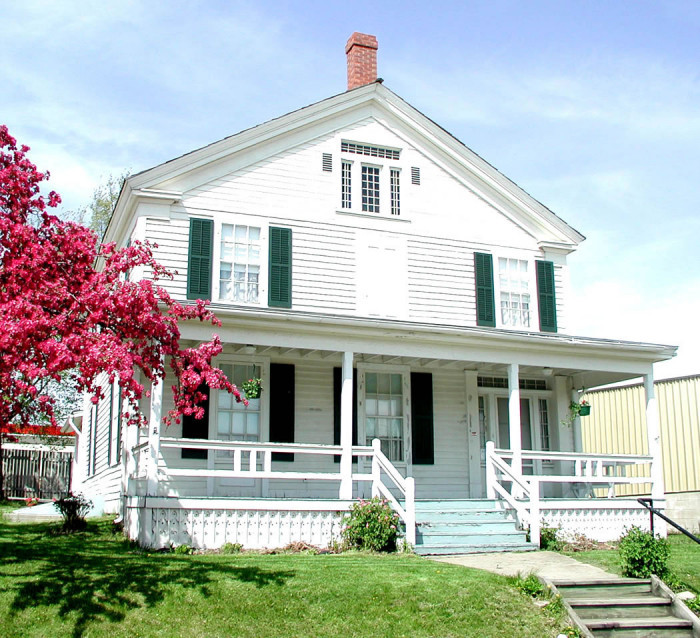
Visitors to the Alexander Faribault House have the opportunity to explore the interior and discover its rich history. Guided tours take visitors through the various rooms, including the parlor, dining room, bedrooms, and kitchen, each furnished with period-appropriate decor and artifacts. The rooms are adorned with intricate woodwork, ornate plasterwork, and original artwork, creating an immersive experience that transports visitors back in time.
The house also features exhibits and displays that highlight the life and accomplishments of Alexander Faribault. As the son of the founder of the city of Faribault, he played a significant role in the early development of the area. Visitors can learn about his contributions to education, fur trading, and his role as an interpreter with Native American tribes. The exhibits provide a deeper understanding of the historical context in which the house was built and the influential figures who shaped the region.
Surrounded by beautifully landscaped grounds, the Alexander Faribault House offers a serene and picturesque setting. Visitors can take leisurely walks through the gardens, which are meticulously maintained and provide an opportunity to appreciate the natural beauty that complements the historic residence.
The preservation and restoration efforts of the Alexander Faribault House have been instrumental in ensuring its continued significance. The house has been listed on the National Register of Historic Places, recognizing its architectural and historical importance. By opening its doors to the public, the house allows visitors to connect with the past, fostering a deeper appreciation for the heritage and culture of the Faribault area.
A visit to the Alexander Faribault House is a journey into the early history of Minnesota and the remarkable legacy of Alexander Faribault. It offers a unique opportunity to explore a well-preserved historic home, admire its architectural beauty, and gain insights into the lives of the individuals who shaped the region. The Alexander Faribault House stands as a living testament to the rich heritage of Faribault and the enduring spirit of those who came before us.
James J. Hill House
240 Summit Avenue, St. Paul, MN
Museum Hours: Thursday to Sunday, 11 am to 3:30 pm. Check their website for up-to-date admission fees.
Website: James J. Hill House
The James J. Hill House, located in St. Paul, Minnesota, is an iconic historic landmark that stands as a testament to the vision, success, and legacy of James Jerome Hill, one of the most influential figures in the development of the American railroad industry. Completed in 1891, this stunning mansion showcases the opulence and grandeur of the Gilded Age.
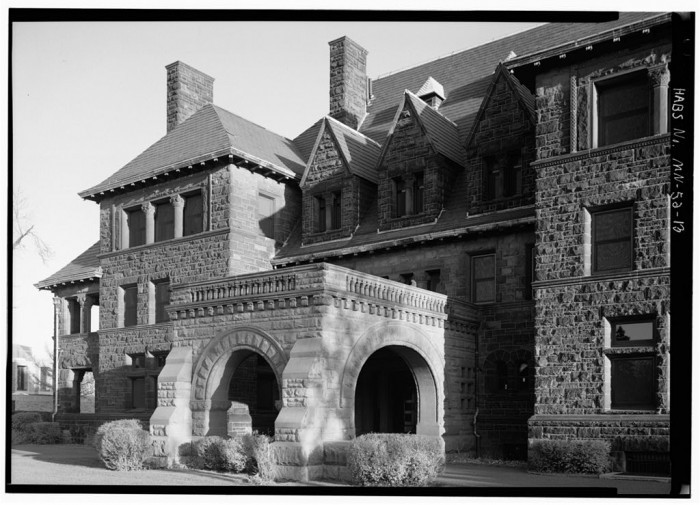
Designed by renowned architect Clarence H. Johnston Sr., the James J. Hill House is a remarkable example of Richardsonian Romanesque architecture. It's imposing exterior features a red sandstone facade, intricate carvings, and a distinctive turreted roofline. The house stands as a testament to the wealth and sophistication of the Hill family, who spared no expense in creating a magnificent residence that would impress visitors and reflect their elevated social status.
Stepping inside the James J. Hill House is like entering a bygone era of elegance and refinement. The interior of the house boasts lavish furnishings, intricate woodwork, and ornate detailing throughout. From the grand staircase to the elaborately decorated reception rooms, each space exudes a sense of luxury and sophistication. Visitors can explore the various rooms, including the music room, library, art gallery, and bedrooms, all adorned with exquisite artwork, fine furnishings, and unique artifacts.
Guided tours of the James J. Hill House provide visitors with a fascinating glimpse into the life of the Hill family and the historic context in which they lived. Knowledgeable guides share stories about James J. Hill's rise to prominence in the railroad industry, his entrepreneurial spirit, and his significant contributions to the development of the American Northwest. The tours offer insights into the family's daily life, social gatherings, and the cultural influences that shaped their tastes and interests.
Beyond its architectural and historical significance, the James J. Hill House is also a cultural center that hosts a variety of events and programs. From concerts and lectures to art exhibitions and educational workshops, these offerings provide visitors with a deeper appreciation for the arts, culture, and history.
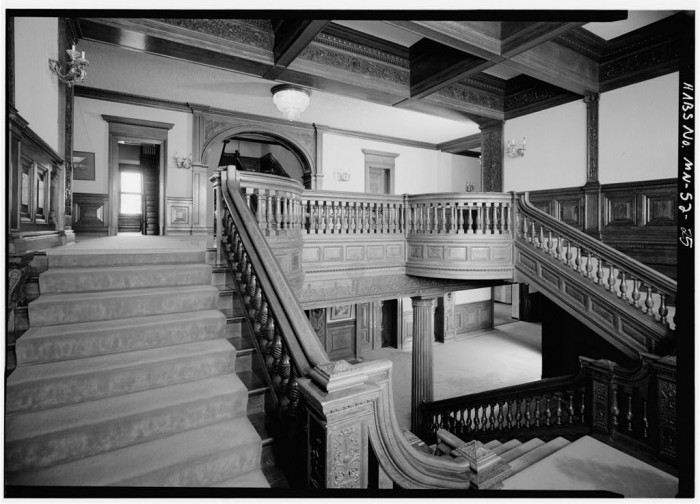
Surrounded by beautifully landscaped grounds, the James J. Hill House offers a serene oasis in the heart of the city. The expansive lawn and gardens provide a tranquil setting for visitors to relax, stroll, and appreciate the natural beauty that complements the grandeur of the mansion.
The preservation and restoration efforts of the James J. Hill House have been instrumental in ensuring its continued significance. The house has been designated a National Historic Landmark and is managed by the Minnesota Historical Society, which is dedicated to preserving and interpreting the site for future generations.
A visit to the James J. Hill House is a captivating journey into the past, offering a glimpse into the luxurious lifestyle of one of America's most influential businessmen. It provides a unique opportunity to immerse oneself in the elegance and grandeur of the Gilded Age while gaining a deeper understanding of the history and cultural heritage of St. Paul and the railroad industry. The James J. Hill House stands as a remarkable testament to the achievements and legacy of James J. Hill, leaving an indelible mark on the landscape of Minnesota and the nation as a whole.
Alexander Ramsey House
265 South Exchange Street, St. Paul, MN
Museum Hours: Saturday 10 am to 3 pm. Check their website for up-to-date admission fees.
Website: Alexander Ramsey House
The Alexander Ramsey House, located in St. Paul, Minnesota, is a historic gem that offers a captivating glimpse into the life and times of Alexander Ramsey, the first territorial governor of Minnesota. Built-in 1872, this elegant Victorian-era residence showcases the architectural beauty and refined taste of the era.
The Ramsey House is a prime example of the Italianate architectural style, characterized by its symmetrical facade, ornate details, and spacious rooms. The exterior of the house features decorative brackets, arched windows, and a prominent tower, which adds to its grandeur and charm. The meticulous restoration efforts have preserved the house's original splendor, allowing visitors to step back in time and experience the opulence of the Victorian era.
Inside the Ramsey House, visitors are treated to a carefully curated journey through the past. Guided tours lead guests through the various rooms, each lovingly restored and furnished with period-appropriate decor. From the lavish parlor to the formal dining room, every space exudes elegance and sophistication. Intricate woodwork, ornate plaster ceilings, and antique furnishings transport visitors to a bygone era of refined living.
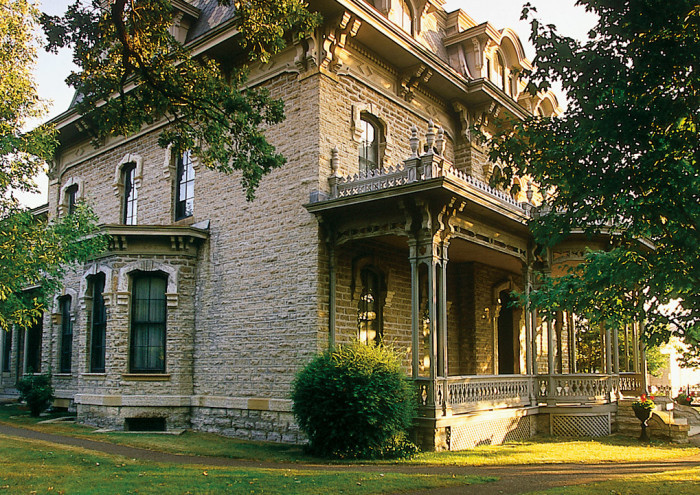
The Ramsey House also offers an opportunity to learn about the fascinating life of Alexander Ramsey and his contributions to Minnesota's history. Exhibits and displays shed light on his political career, his role in shaping the development of the state, and his connections to significant events such as the Civil War and the Dakota Conflict of 1862. Visitors can gain insights into Ramsey's life as a public figure and his family's influence on the growth of St. Paul and Minnesota as a whole.
The beautifully landscaped grounds surrounding the Ramsey House further enhance the visitor experience. Lush gardens, vibrant flowers, and serene pathways invite visitors to explore and appreciate the natural beauty that complements the architectural splendor of the house. The tranquil outdoor spaces provide a peaceful setting for reflection and relaxation.
Preservation and restoration efforts have been crucial in maintaining the historical integrity of the Ramsey House. The house has been listed on the National Register of Historic Places and is managed by the Minnesota Historical Society, ensuring its continued significance as a cultural and educational destination.
A visit to the Alexander Ramsey House offers a fascinating journey into the past, providing a unique opportunity to immerse oneself in the Victorian era and gain a deeper understanding of the history and heritage of Minnesota. The Ramsey House stands as a testament to the accomplishments and legacy of Alexander Ramsey, leaving a lasting impact on the state's political, social, and architectural landscape.
The Glensheen Mansion
3300 London Road, Duluth, MN
Museum Hours: Open Daily, 9 am to 5 pm, last full mansion tour at 4:30 pm. Check their website for up-to-date admission fees.
Website: The Glensheen Mansion
The Glensheen mansion, situated on the shores of Lake Superior in Duluth, Minnesota, is an architectural masterpiece that combines grandeur, beauty, and rich history. Built between 1905 and 1908, this magnificent mansion stands as a testament to the wealth and opulence of the Congdon family, one of the region's most prominent families.
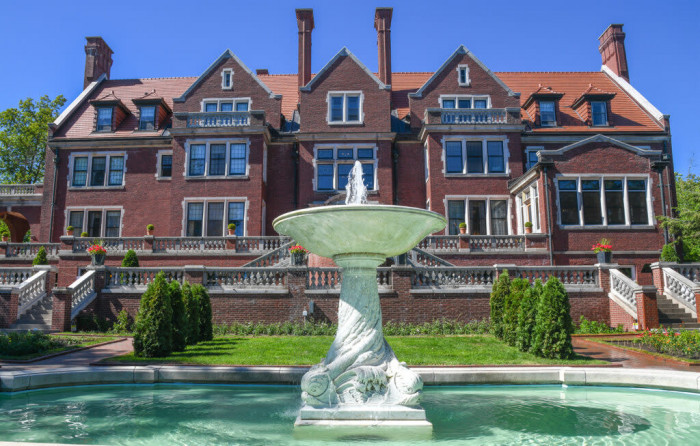
Designed by architect Clarence H. Johnston Sr. in the Jacobean Revival style, Glensheen is an exquisite example of architectural craftsmanship. It's exterior features a blend of stone, brick, and half-timbering, with striking gables, turrets, and decorative elements that make it an iconic landmark. The mansion's sprawling grounds encompass lush gardens, scenic trails, and breathtaking views of Lake Superior, creating a truly picturesque setting.
Visitors to Glensheen are treated to a comprehensive tour that allows them to step into the world of the Congdon family. Knowledgeable guides lead visitors through the lavishly furnished rooms, showcasing the family's impeccable taste and refined lifestyle. From the grand entrance hall to the elegant bedrooms, each space is adorned with exquisite furniture, original artwork, and fine details that transport visitors back to the early 20th century.
One of the highlights of the mansion is the opulent living room, featuring intricate woodwork, a grand fireplace, and stunning stained glass windows. The formal dining room, complete with a magnificent chandelier and a table set for an elegant dinner, offers a glimpse into the family's entertaining traditions. The sun porch, overlooking the lake, provides a serene retreat with breathtaking views.
The Glensheen mansion is also famous for its intriguing history, including the infamous Congdon murders that occurred in 1977. Visitors can explore the mansion's hidden passages and secret rooms, gaining insights into the events that unfolded within its walls. The tragic story adds an air of mystery and intrigue, making the mansion all the more captivating.
In addition to the mansion, the Glensheen estate offers a variety of outdoor activities. Visitors can wander through the meticulously maintained gardens, stroll along the lakeshore, or enjoy a picnic in the scenic surroundings. The estate also hosts events, concerts, and educational programs throughout the year, providing opportunities for visitors to engage with the history and culture of the region.
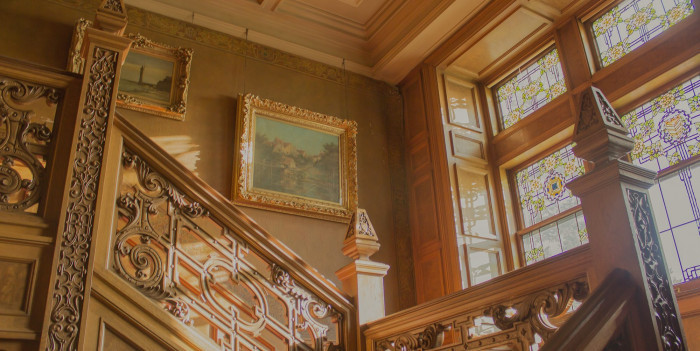
The preservation and restoration efforts undertaken by the University of Minnesota Duluth, which now manages the Glensheen estate, have ensured that this architectural gem remains in pristine condition. Listed on the National Register of Historic Places, Glensheen serves as a cultural and educational center, allowing visitors to appreciate the beauty of the mansion, learn about the family's legacy, and explore the historical significance of the region.
A visit to the Glensheen mansion is a journey into a bygone era, offering a glimpse into the lives of the affluent Congdon family and the splendor of early 20th-century architecture. With its breathtaking setting, captivating history, and meticulous preservation, Glensheen continues to be a beloved destination that leaves a lasting impression on all who experience its grandeur.
The Burwell House
13209 East McGinty Road, Minnetonka, MN
Museum Hours: Check their website for tour information
Website: The Burwell House
The Burwell House, located in Minnetonka, Minnesota, is a historic treasure that provides a fascinating glimpse into the early settlement of the area and the lives of the Burwell family. Built-in 1883, this charming Victorian-era residence stands as a testament to the perseverance and ingenuity of the pioneers who settled in the region.
The Burwell House showcases a beautiful blend of architectural styles, combining elements of Gothic Revival and Italianate design. Its distinctive features include ornate woodwork, intricate detailing, and a picturesque wrap-around porch that invites visitors to step back in time. The exterior of the house has been meticulously restored, capturing the essence of its original splendor and retaining its historical charm.
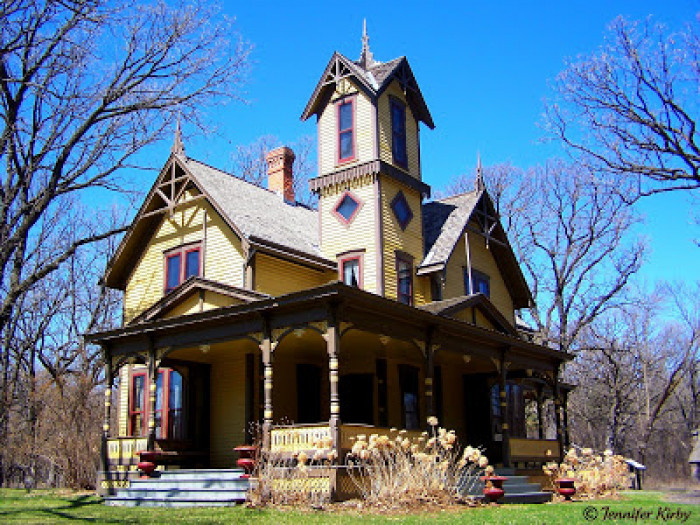
A visit to the Burwell House offers a unique opportunity to explore the interior and discover its rich history. Guided tours take visitors through the various rooms, allowing them to experience the home as it would have been during the late 19th and early 20th centuries. The rooms are furnished with period-appropriate decor and artifacts, creating an immersive experience that transports visitors back to a time of simplicity and grace.
The Burwell House also serves as a cultural center that hosts a variety of events, programs, and exhibitions. From art shows and music performances to historical presentations and educational workshops, these offerings provide visitors with a deeper appreciation for the arts, history, and culture of the Minnetonka area.
Surrounded by picturesque grounds, the Burwell House offers a peaceful retreat from the hustle and bustle of modern life. Visitors can stroll through the beautifully landscaped gardens, take in the scenic views, and enjoy the tranquility of the natural surroundings. The serene ambiance adds to the overall charm of the property and creates a serene setting for relaxation and reflection.
The preservation and restoration efforts undertaken by the Minnetonka Historical Society have been instrumental in maintaining the historical integrity of the Burwell House. The house has been listed on the National Register of Historic Places, recognizing its architectural significance and its role in preserving the heritage of the Minnetonka community.
A visit to the Burwell House is a journey into the past, offering a glimpse into the lives of the early settlers who helped shape the Minnetonka area. It provides a unique opportunity to immerse oneself in the history and culture of the region while appreciating the architectural beauty and timeless elegance of this well-preserved Victorian home. The Burwell House stands as a cherished symbol of Minnetonka's heritage, inviting visitors to step back in time and discover the stories that have shaped the community.
Sibley Historic Site
1357 Sibley Memorial Highway, Mendota, MN
Museum Hours: Saturday and Sunday 10 am to 4 pm
Website: Sibley Historic Site
Well not a mansion, the Sibley Historic Site, located in Mendota, Minnesota, is a captivating destination that invites visitors to explore the rich history and cultural heritage of the region. The site encompasses several historic buildings associated with Henry Hastings Sibley, a prominent figure in Minnesota's history and the state's first governor.
At the heart of the Sibley Historic Site stands the Sibley House, which holds the distinction of being the oldest stone house in Minnesota. Built-in 1836, this sturdy structure showcases the unique blend of European and Native American influences that shaped the early settlement of the region. The Sibley House offers guided tours that take visitors through the various rooms, providing insights into Sibley's life, his relationships with Native American tribes, and the challenges faced by early settlers.
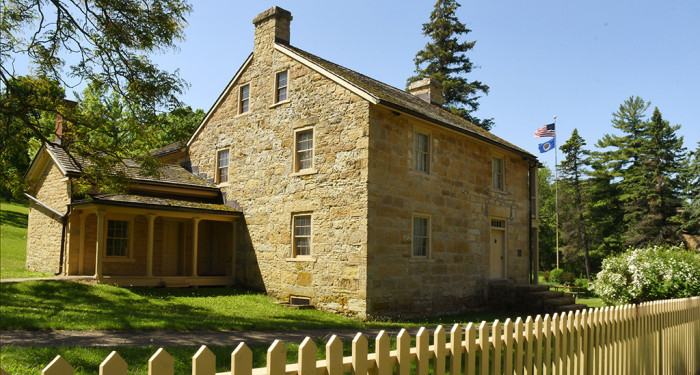
In addition to the Sibley House, the site features other historic buildings and structures, including the Dupuis House and the W.W. Mayo House. The Dupuis House, constructed in 1843, provides a glimpse into the life of early French-Canadian settlers in the area. The W.W. Mayo House, built in 1859, belonged to the Mayo family, known for their contributions to medicine and the establishment of the renowned Mayo Clinic.
The Sibley Historic Site offers visitors the opportunity to engage with history through a variety of activities and events. Guided tours, led by knowledgeable interpreters, delve into the stories of the site's buildings and the people who inhabited them. Interactive exhibits provide a hands-on exploration of the region's history, including the fur trade, the early settlement period, and the relationships between European settlers and Native American tribes.
The site also hosts special events and programs that showcase different aspects of Minnesota's history and culture. From traditional craft demonstrations to historical reenactments, these events offer a deeper understanding of the daily lives and customs of the people who shaped the region.
Surrounded by picturesque landscapes and scenic views of the Minnesota River, the Sibley Historic Site provides a serene and immersive experience. Visitors can take leisurely walks along the site's nature trails, enjoy a picnic in the park, or simply soak in the tranquil atmosphere while learning about the area's rich past.
The Sibley Historic Site stands as a testament to the early days of settlement in Minnesota and the cultural interactions that shaped the region's history. It preserves and celebrates the stories, traditions, and contributions of the people who played a significant role in its development. A visit to the Sibley Historic Site offers a captivating journey into Minnesota's past, providing a deeper appreciation for the diverse and vibrant heritage of the area.
Go and visit amazing Minnesota mansions and historic homes
Visiting historic mansions in Minnesota offers a captivating journey through time, providing a window into the lives of influential figures, the architectural splendor of the past, and the cultural heritage of the state. These grand homes stand as a testament to the vision, wealth, and artistry of their creators, showcasing a variety of architectural styles and design influences.
From the stately James J. Hill House in St. Paul to the elegant Glensheen mansion in Duluth, each mansion tells a unique story and offers a distinct experience. The meticulous restoration and preservation efforts undertaken by historical societies and organizations ensure that these architectural gems continue to shine, allowing visitors to appreciate their original grandeur.
Exploring the interiors of these historic mansions reveals a wealth of historical and cultural treasures. Lavishly furnished rooms, ornate details, and well-preserved artifacts transport visitors to a bygone era of opulence and refinement. Guided tours provide valuable insights into the lives of the families who once called these mansions home, offering a glimpse into their social standing, aspirations, and contributions to the development of Minnesota.
Beyond the architectural and historical significance, these mansions often serve as cultural centers, hosting events, exhibitions, and educational programs that deepen our understanding of the past. From art exhibits to music performances, these offerings create a dynamic and enriching experience for visitors of all ages.
Surrounded by beautifully landscaped grounds and breathtaking natural scenery, these historic mansions offer more than just a glimpse into the past. They provide a serene escape from the present, allowing visitors to appreciate the tranquility and beauty of their surroundings while reflecting on the rich history that shaped the state.
Planning your visit to historic mansions in Minnesota is not only a delightful exploration of architecture and history but also an opportunity to connect with the stories, traditions, and heritage of the region. Whether you are a history enthusiast, an architecture lover, or simply seeking a unique cultural experience, these grand homes are sure to leave a lasting impression, inspiring a sense of wonder and appreciation for the rich tapestry of Minnesota's past.
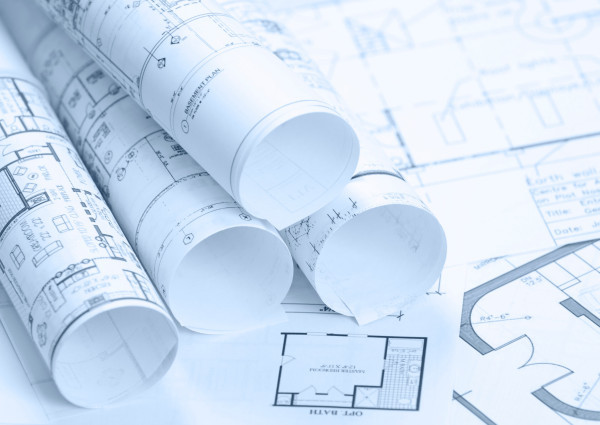
Unlocking the secrets of your home's design and construction: A comprehensive guide to locating and utilizing your home's blueprints
Want to learn more about your home's design and construction? Here's everything you need to know about your home's blueprints to find out.
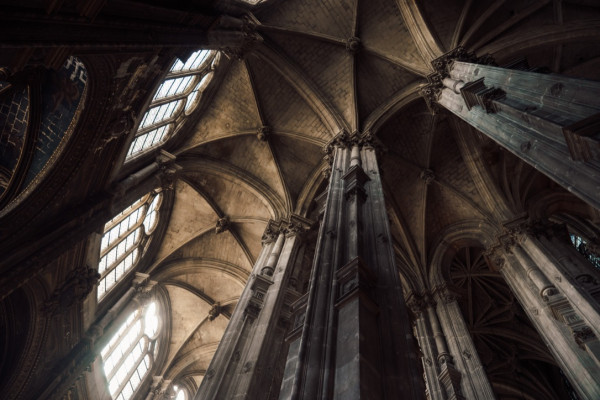
Beyond Thrilling Experience of Buying a Historic Property
You might have always fancied living in an 18th-century property with Georgian architecture, or a 19th-century exotic mansion.

How to Search Property Records and Learn Everything About a House: Find Land Records
Uncover the Past of Old Houses: A Comprehensive Guide to Researching Property Records and Gaining Insights About a House's History Through Land Records

How to Prevent a Property from Becoming Abandoned
As a result of the United States housing foreclosure crisis from 2007-2010, the amount of foreclosed, abandoned, and unclaimed properties drastically increased, which can diminish the market value of surrounding properties.